Topic: Gravity
Gravity
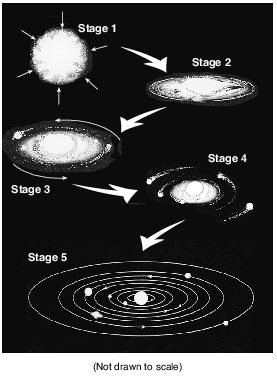
Which force was mostly responsible for the contraction of the gas cloud?
(1) friction
(2) gravity
(3) magnetism
(4) inertia

What causes the gas and dust cloud to condense and become a star?
(1) density
(2) friction
(3) gravity
(4) outgassing
Which statement best explains why Earth and the other planets of our solar system became layered as they were being formed?
(1) Gravity caused less-dense material to move toward the center of each planet.
(2) Gravity caused more-dense material to move toward the center of each planet.
(3) Materials that cooled quickly stayed at the surface of each planet.
(4) Materials that cooled slowly stayed at the surface of each planet.
Which two factors caused the interior layering of Earth and other planets in our solar system during their formation?
(1) cosmic background radiation and density differences
(2) cosmic background radiation and specific heat
(3) gravity and density differences
(4) gravity and specific heat
Early in its formation, Earth was a molten mass of evenly mixed composition. During the next few million years, the heavier and more dense elements sank to the center, while lighter and less dense elements rose toward the surface. This is called chemical fractionation.

Chemical fractionation is most likely caused by
(1) solidification
(2) gravity
(3) magnetic force
(4) chemical weathering
Explain why the Moon’s gravity has a greater effect on Earth’s ocean tides than the Sun’s gravity. [1]
Allow 1 credit. Acceptable responses include, but are not limited to:
• — The Moon is closer to Earth so gravity is greater.
• — The Sun is much farther away.

Identify the force that caused stars and planets in the universe to become layered according to density differences in their composition. [1]
Allow 1 credit. Acceptable responses include, but are not limited to:
• — gravity
• — gravitational attraction/gravitational pull
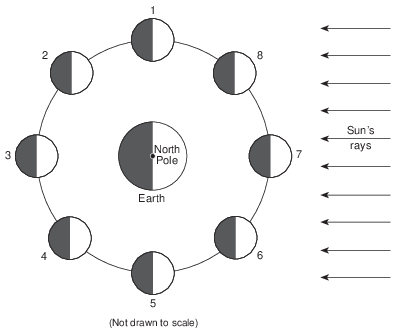
Explain why the Moon’s orbital velocity is slowest when the Moon is farthest from Earth. [1]
Allow 1 credit. Acceptable responses include, but are not limited to:
• — The gravitational attraction between the Moon and Earth is least when they are farthest
• apart.
• — The force of gravity is less.
• — Gravitational attraction is greater when the Moon is closer to Earth.
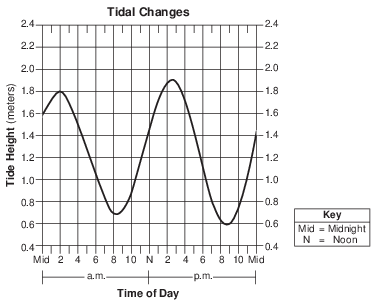
Explain why the Moon has a greater influence on Earth tides than the Sun. [1]
Allow 1 credit. Acceptable responses include, but are not limited to:
• — The Moon is closer to Earth.
• — The Moon’s gravitational pull is stronger because the Moon is closer to Earth than the Sun is.
• Note: Do not allow credit for “The Moon’s gravity is stronger” alone because the Moon’s distance
• from Earth is not described.

Identify the force responsible for the contraction of a nebula (a gas cloud of molecules) to form a protostar. [1]
Allow 1 credit. Acceptable responses include, but are not limited to:
• — gravity
• — gravitational attraction
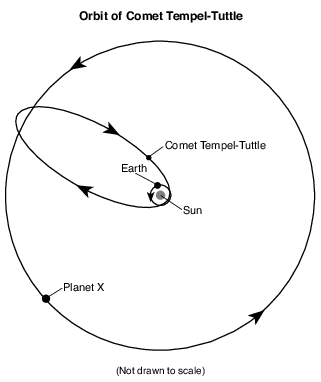
Comet Tempel-Tuttle
Comet Tempel-Tuttle orbits our Sun and is responsible for the Leonid meteor shower event observed from Earth. This meteor shower occurs every year in November and is visible in the night sky as Earth passes through the debris left in space by this comet. The debris from the comet produces meteors that are smaller than a grain of sand, which enter Earth’s atmosphere and burn up in the mesosphere temperature zone. Comet Tempel-Tuttle’s orbital distance from the Sun ranges from about 145 million kilometers at its closest approach to 2900 million kilometers at its farthest distance. Its two most recent closest approaches to the Sun occurred in 1965 and one revolution later in 1998.
Identify the force that causes debris from the comet to fall through Earth’s atmosphere. [1]
Allow 1 credit for gravity or gravitation or gravitational pull.
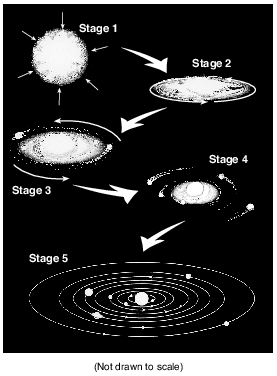
Identify the force that was primarily responsible for contracting the gas cloud in stage 1. [1]
Allow 1 credit for gravity or gravitational force.

The orbital velocity of Earth is sometimes faster and sometimes slower than its average orbital velocity. Explain why the orbital velocity of Earth varies in a cyclic pattern. [1]
Allow 1 credit. Acceptable responses include, but are not limited to:
• — Earth’s distance to the Sun changes in a cyclic pattern.
• — Gravity is greater when Earth is closer to the Sun.
• — Earth moves slower when it is farther from the Sun.
• — Earth has an elliptical/slightly eccentric orbit.
